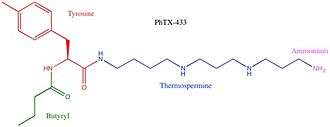Philanthotoxin
 | |
| Names | |
|---|---|
| IUPAC name
N-[(2S)-1-[4-[3-(3-Aminopropylamino)propylamino]butylamino]-3-(4-hydroxyphenyl)-1-oxopropan-2-yl]butanamide | |
| Identifiers | |
| 3D model (JSmol) |
|
| ChemSpider | |
| PubChem CID |
|
| |
| |
| Properties | |
| C23H41N5O3 | |
| Molar mass | 435.603 g/mol |
| Except where otherwise noted, data are given for materials in their standard state (at 25 °C [77 °F], 100 kPa). | |
| | |
| Infobox references | |
Philanthotoxins are components of the venom of the Egyptian solitary wasp Philanthus triangulum, commonly known as the European beewolf. Philanthotoxins are polyamine toxins, a group of toxins isolated from the venom of wasps and spiders which immediately but reversibly paralyze their prey.[1] δ-philanthotoxin, also known as PhTX-433, is the most active philanthotoxin that can be refined from the venom.[2] PhTX-433 functions by blocking excitatory neurotransmitter ion channels, including nicotinic acetylcholine receptors (NAChRs) and ionotropic glutamate receptors (iGluRs).[3] While the IC50 values of philanthotoxins varies between analogues and receptor subunit composition, the IC50 value of PhTX-433 at the iGluR AMPA receptor naturally expressed in locust leg muscle is 18 μm and the IC50 value at rat nAChRs is 1 μm.[4][5]
Mechanism of Action
Philanthotoxins reversibly inhibit AMPA (also called the "quisqualate receptor"), kainate, and NMDA ionotropic glutamate receptors.[3] Philanthotoxins have a hydrophobic aromatic head group and a hydrophilic polyamine tail, which allow them to inhibit iGluRs by binding within the ion channel.[6] Inhibition may also occur via binding to an external allosteric polyamine binding site.[5] Subunit composition of iGluRs heavily influences the efficacy of philanthotoxins. For example, AMPA receptors lacking the GluA2 subunit are highly sensitive to PhTX-433, whereas receptors containing the GluA2 subunit are nearly entirely insensitive.[3] In addition, PhTX-433 inhibits both vertebrate and insect nAChRs predominantly by non-competitively blocking the ion channel in its open conformation.[7][8]

Isolation and synthesis
PhTX-433 was structurally elucidated and subsequently synthesized in 1988 by Eldefrawi and colleagues.[9] Because PhTX-433 lacks strong receptor subtype selectivity, a variety of analogs have been synthesized as candidates for potential pharmacological exploitation.[6] Philanthotoxins have four distinct regions that can be modified (see image at right); the number of nitrogens in the polyamine chain is the most common distinction between synthetic analogs.[6] The most commonly synthesized and studied analogue is PhTX-343, which has similar properties to PhTX-433.[6]
Uses
Analogues with IC50 values in the low nano-molar and pico-molar range have been identified and studied.[6] Combined with the potential for precise receptor subtype selectivity, synthetic philanthotoxins could be used as highly potent and selective inhibitors for nAChRs and iGluRs. Glutamate is the main excitatory neurotransmitter in the mammalian brain and has been implicated in mediating neurological disorders such as epilepsy and neurodegenerative diseases such as Huntington's disease.[9] Therefore, there is considerable interest in the therapeutic development of iGluR antagonists as anticonvulsants, muscle relaxants, and agents to protect from ischemic brain damage and possibly neurodegeneration.[9] In addition, because nAChRs are the major excitatory neurotransmitter gated ion channels in insects, philanthotoxins may be developed as insecticides.[9][6]
References
- ↑ Strømgaard, K.; Jensen, L. S.; Vogensen, S. B. (2005). "Polyamine toxins: development of selective ligands for ionotropic receptors". Toxicon. 45 (3): 249–254. Retrieved 23 April 2017.
- ↑ Piek, T. (1982). "δ-Philanthotoxin, a semi-irreversible blocker of ion-channels". Comparative Biochemistry and Physiology Part C: Comparative Pharmacology. 72 (2): 311–315.
- 1 2 3 Kachel, H.S.; Patel, R.N.; Franzyk, H.; Mellor, I.R. (2016). "Block of nicotinic acetylcholine receptors by philanthotoxins is strongly dependent on their subunit composition". Scientific Reports. 6.
- ↑ Bruce, M.; Bukownik, R.; Eldefrawi, A. T.; Eldefrawi, M. E.; Goodnow, R.; Kallimopoulos, T.; Konno, K.; Nakanishi, K.; Niwa, M.; Usherwood, P. N. R. (1990). "Structure-activity relationships of analogues of the wasp toxin philanthotoxin: non-competitive antagonists of quisqualate receptors". Toxicon. 28: 11.
- 1 2 Anis, N.; Sherby, S.; Goodnow, R.; Niwa, M.; Konno, K.; Kallimopoulos, T.; Bukownik, R.; Nakanishi, K.; Usherwood, P.; Eldefrawi, A. (1990). "Structure-activity relationships of philanthotoxin analogs and polyamines on N-methyl-D-aspartate and nicotinic acetylcholine receptors". Journal of Pharmacology and Experimental Therapeutics. 254 (3).
- 1 2 3 4 5 6 Kachel, H. (2015). Inhibition of mammalian nicotinic acetylcholine receptors by philanthotoxin analogues is strongly influenced by subunit composition. Nottingham ePrints.
- ↑ Jayaraman, V.; Usherwood, P. N.; Hess, G. P. (1999). "Inhibition of nicotinic acetylcholine receptor by philanthotoxin-343: kinetic investigations in the microsecond time region using a laser-pulse photolysis technique". Biochemistry. 38 (35): 11406–11414.
- ↑ Rozental, R.; Scoble, G. T.; Albuquerque, E. X.; Idriss, M.; Sherby, S.; Sattelle, D. B.; Nakanishi, K.; Konno, K.; Eldefrawi, A. T. (1989-04-01). "Allosteric inhibition of nicotinic acetylcholine receptors of vertebrates and insects by philanthotoxin.". Journal of Pharmacology and Experimental Therapeutics. 249 (1): 123–130. ISSN 0022-3565. PMID 2468760.
- 1 2 3 4 Eldefrawi, A. T.; Eldefrawi, M. E.; Konno, K.; Mansour, N.A.; Nakanishi, E.; Oltz, E.; Usherwood, P. N. R. (1988). "Structure and synthesis of a potent glutamate receptor antagonist in wasp venom". Proc. Natl Acad. Scie. 85: 4910.